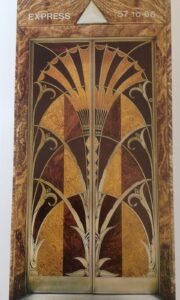 A gift the universe gives the right person is rare. Take Emma Howard, a talented local designer who gave me permission to use her name. She owns Studio 3 Hand Rendered Textiles and Surface Designs. While visiting her son she spotted a designer’s dream in front of a vacant house. Against the heap of old furniture leaned a vintage graphic design work, rendered by hand with old-fashioned tools of water based gouache, a paint brush, and a ruling pen, supported on a heavy paper board. The uneven edges of the design told Emma she found a hand-done work. No need for an artist to make perfectly finished edges because this template served as a basis for a side by side fabric design for a woven or printed fabric.
A gift the universe gives the right person is rare. Take Emma Howard, a talented local designer who gave me permission to use her name. She owns Studio 3 Hand Rendered Textiles and Surface Designs. While visiting her son she spotted a designer’s dream in front of a vacant house. Against the heap of old furniture leaned a vintage graphic design work, rendered by hand with old-fashioned tools of water based gouache, a paint brush, and a ruling pen, supported on a heavy paper board. The uneven edges of the design told Emma she found a hand-done work. No need for an artist to make perfectly finished edges because this template served as a basis for a side by side fabric design for a woven or printed fabric.
Emma asked my opinion on the age of the piece. It lost its frame and glazing on the street that day, but remains in remarkable condition. I know two ways to research date of creation. One is to research the technical developments in graphic design, or more to the point, the history of 3D designs from the pen to CAD for a computer.
The Other Way to Research this Work’s Era
Compare it to other graphic designs in selected STYLES: a stylistic/artistic analysis. I researched a few select eras. One, the 1920-1930s when graphic design moved from Art Nouveau to Art Deco. The other era, 1950-1960, for graphic design influenced by Op Art.
Let’s take the technological approach. When did two and three-D software become predominant over hand rendered graphic design? Understandably an artist in 2025 creates a graphic design by hand, but the likelihood of a hand-rendered work created before such software is higher. Computer assisted 3D design didn’t becoming a future industry standard until the 1980s. Affordable personal computers helped in the early 1990s.
The first 2D software called “Sketchpad” launched in 1969. IBM released the first affordable PC in 1981. So the design Emma found either came from the Art Deco period OR the Op Art period. Both eras involved graphic designers who predominantly worked by hand.
Art Deco vs. Op Art Graphic Design
The characteristics of Art Deco design, prevalent for a few years in the US 1920-30 include: bold, graphic shapes, strong lines, unusually rich colors with black or old metallic accents, glamour, luxury, zigzags, triangles, chevrons, streamlined patterns, clear order, symmetry. Those words sounded evocative for this period.
What characterizes Op Art design, mid-1950 to mid-1960s? Primary or slightly off primary (neon) vivid, eye-popping colors, repeating abstract patterns, clean geometric shapes and layouts, abstract repetitions. Which of these two stylistic eras best reflect the treasure that Emma found?
I compared Emma’s creation to my very favorite Deco design, the gorgeously rich elevator doors of the Chrysler building’s lobby in Manhattan. William Van Alen designed those doors in 1927-1930. They’re not PURE deco as he borrowed from the previous stylistic era (Nouveau) as we see by a hint of an exotic organic curvilinear line. The colors have rich deep tones, exotic wood, and gold leafing.
The colors of Emma’s treasure leads me to believe the stylistic period is likely NOT Deco, yellows and sky blues weren’t typical. Plus the paperboard looks in unusually good shape for a hundred year old board. It makes me lean towards the 1960s.
Importance of Fabric Design
In the USA we’ve always considered design for fabrics important. Amazingly we see the cult of George Washington in 18th century textiles. His image on fabrics is ubiquitous, printed from copper plate or woven, with early Federal images of the eagle. One fabric shows “The Apotheosis of Ben Franklin,” a tribute to Franklin on his death in 1790, with George Washington leading his funeral cortege drawn by leopards. Franklin floats in a beaver fur cap. The Bauhaus (1920-1930) offered a degree in textile design, and geometric woven wool wall hanging produced in this era are artworks. Frank Lloyd Wright in 1950s designs were made by Schumacher Co and became iconic and highbrow purchases.
I place a value of $2,500 on Emma’s work of graphic art.